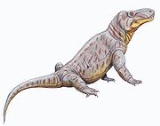
Titanosuchus
Encyclopedia
Titanosuchus ferox was a dinocephalia
n therapsid that lived in the Mid Permian
epoch in South Africa
. Despite the name, it was not related to crocodile
s.
Along with its close relatives, Jonkeria
and Moschops
, Titanosuchus inhabited present-day South Africa around 255 million years ago, in the Late Permian. Titanosuchus was a carnivore
and might have eaten both Jonkeria and Moschops, among other vertebrates. Its teeth included sharp incisors and fang-like canines
, perfect for biting prey.
Titanosuchus rivals that to Titanophoneus
, which is also a carnivore and a dinocephalian, but it lived only in Russia
. Titanosuchus should not be confused with the therapsid Eotitanosuchus
, which belonged to a different family
.
Dinocephalia
Dinocephalia are a clade of large early therapsids that flourished during the Middle Permian, but became extinct leaving no descendants.-Description:...
n therapsid that lived in the Mid Permian
Permian
The PermianThe term "Permian" was introduced into geology in 1841 by Sir Sir R. I. Murchison, president of the Geological Society of London, who identified typical strata in extensive Russian explorations undertaken with Edouard de Verneuil; Murchison asserted in 1841 that he named his "Permian...
epoch in South Africa
South Africa
The Republic of South Africa is a country in southern Africa. Located at the southern tip of Africa, it is divided into nine provinces, with of coastline on the Atlantic and Indian oceans...
. Despite the name, it was not related to crocodile
Crocodile
A crocodile is any species belonging to the family Crocodylidae . The term can also be used more loosely to include all extant members of the order Crocodilia: i.e...
s.
Along with its close relatives, Jonkeria
Jonkeria
Jonkeria was a very large herbivorous dinocephalian, from the Tapinocephalus Assemblage Zone, Lower Beaufort Group, of the South African Karroo...
and Moschops
Moschops
Moschops is an extinct genus of therapsid that lived in the Late Permian, around 255 million years ago. Therapsids were proto-mammals , which were the dominant land animals. Five metres long, Moschops was the largest land animal of its time, a herbivore preyed on by other therapsids...
, Titanosuchus inhabited present-day South Africa around 255 million years ago, in the Late Permian. Titanosuchus was a carnivore
Carnivore
A carnivore meaning 'meat eater' is an organism that derives its energy and nutrient requirements from a diet consisting mainly or exclusively of animal tissue, whether through predation or scavenging...
and might have eaten both Jonkeria and Moschops, among other vertebrates. Its teeth included sharp incisors and fang-like canines
Canine tooth
In mammalian oral anatomy, the canine teeth, also called cuspids, dogteeth, fangs, or eye teeth, are relatively long, pointed teeth...
, perfect for biting prey.
Titanosuchus rivals that to Titanophoneus
Titanophoneus
Titanophoneus potens was a carnivorous Therapsid of the Dinocephalia group related to the Estemmenosuchidae, but living 5 million years later than Estemmenosuchus, during the Late Permian. Remains of this animal have been found at Isheevo in RussiaAn adult skull would have reached 80 cm with a...
, which is also a carnivore and a dinocephalian, but it lived only in Russia
Russia
Russia or , officially known as both Russia and the Russian Federation , is a country in northern Eurasia. It is a federal semi-presidential republic, comprising 83 federal subjects...
. Titanosuchus should not be confused with the therapsid Eotitanosuchus
Eotitanosuchus
Eotitanosuchus olsoni is a mammal-like reptile whose fossils were found in the town of Ochyor in Perm Krai, Russia, in channel flood deposits along with Biarmosuchus tener, Estemmenosuchus uralensis and Estemmenosuchus mirabilis.It lived about 255 mya and was a very large animal; although the...
, which belonged to a different family
Family (biology)
In biological classification, family is* a taxonomic rank. Other well-known ranks are life, domain, kingdom, phylum, class, order, genus, and species, with family fitting between order and genus. As for the other well-known ranks, there is the option of an immediately lower rank, indicated by the...
.

